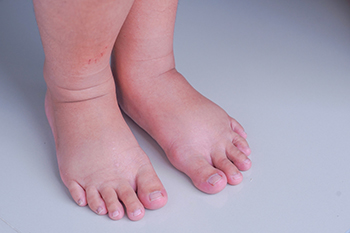Items filtered by date: October 2022
How Does a Stress Fracture Heal?

A stress fracture of the foot can be painful, and it may cause challenges in completing daily activities. It is also known as a hairline fracture, and will gradually worsen if not treated promptly. This type of break is defined as a tiny crack in any of the foot bones, or it may occur in the lower leg. It is a common injury among people who enjoy participating in running and jumping activities, and the bones may gradually become weaker from repetitive use. Additionally, it may happen as a result of increasing speed or mileage too quickly while running. Patients who have nutritional imbalances or who have had previous stress fractures may be prone to having them occur again. This type of fracture is generally treated by resting the affected foot and temporarily stopping the activity that caused this condition. Research has indicated that a complete recovery generally takes approximately eight weeks, and may be accelerated by performing low impact exercises like swimming or cycling. If you have endured a stress fracture, please consider speaking with a podiatrist who can help you with the treatment plan that is correct for you.
Activities where too much pressure is put on the feet can cause stress fractures. To learn more, contact Paul A. Santangelo, DPM from Illinois. Our doctor can provide the care you need to keep your pain free and on your feet.
Dealing with Stress Fractures of the Foot and Ankle
Stress fractures occur in the foot and ankle when muscles in these areas weaken from too much or too little use. The feet and ankles then lose support when walking or running from the impact of the ground. Since there is no protection, the bones receive the full impact of each step. Stress on the feet can cause cracks to form in the bones, thus creating stress fractures.
What Are Stress Fractures?
Stress fractures occur frequently in individuals whose daily activities cause great impact on the feet and ankles. Stress factors are most common among:
- Runners
- People affected with Osteoporosis
- Tennis or basketball players
- Gymnasts
- High impact workouts
Symptoms
Pain from the fractures occur in the area of the fractures and can be constant or intermittent. It will often cause sharp or dull pain with swelling and tenderness. Engaging in any kind of activity which involves high impact will aggravate pain.
If you have any questions please feel free to contact our offices located in Niles and Rockford, IL . We offer the newest diagnostic and treatment technologies for all your foot and ankle needs.
Blisters on the Soles of the Feet

A blister that forms on the bottom of the foot can be extremely uncomfortable. The ball of the foot helps to bear the weight of the body, and it can be susceptible to blisters. The majority of blisters on the feet develop as a result of excess pressure, and the soles are no expectation. The skin on this part of the foot is thicker and doesn’t move as freely as the skin on other parts of the foot, in addition to having several more sweat glands that may lead to high friction. Shoes are generally worn for most of the day, often causing the feet to become sweaty. Additionally, many socks are made with materials that are not breathable, and this may add friction to this part of the foot. Relief may come from wearing a protective bandage on the bottom of the foot and may help in preventing blisters on the feet from developing. Some people choose to put powder in their socks, which absorb excess moisture. If you would like more information about how to treat and prevent blisters on the feet, please consult with a podiatrist who can address any concerns you may have.
Blisters are prone to making everyday activities extremely uncomfortable. If your feet are hurting, contact Paul A. Santangelo, DPM of Illinois. Our doctor can provide the care you need to keep you pain-free and on your feet.
Foot Blisters
Foot blisters develop as a result of constantly wearing tight or ill-fitting footwear. This happens due to the constant rubbing from the shoe, which can often lead to pain.
What Are Foot Blisters?
A foot blister is a small fluid-filled pocket that forms on the upper-most layer of the skin. Blisters are filled with clear fluid and can lead to blood drainage or pus if the area becomes infected.
How Do Blisters Form?
Blisters on the feet are often the result of constant friction of skin and material, usually by shoe rubbing. Walking in sandals, boots, or shoes that don’t fit properly for long periods of time can result in a blister. Having consistent foot moisture and humidity can easily lead to blister formation.
Prevention & Treatment
It is important to properly care for the affected area in order to prevent infection and ease the pain. Do not lance the blister and use a Band-Aid to provide pain relief. Also, be sure to keep your feet dry and wear proper fitting shoes. If you see blood or pus in a blister, seek assistance from a podiatrist.
If you have any questions, please feel free to contact our offices located in Niles and Rockford, IL . We offer the newest diagnostic and treatment technologies for all your foot care needs.
Get Proper Care for a Sports-Related Foot or Ankle Injury This Fall
Swollen Feet and Diabetes May Be Connected

Swollen feet or edema can often accompany the serious condition known as diabetes. Poor circulation may lead to excess fluid in the legs and feet, causing swelling. Gravity plays a significant role in having swollen feet and improving circulation can help to reduce existing swelling. Patients who are diabetic may have damaged veins as a result of poor circulation and may experience kidney issues from having elevated glucose levels. Additionally, the heart may be affected and can become less efficient at pumping blood. All these factors may lead to swollen feet and may be helped by consuming a diet that is low in sodium. It also may help to drink plenty of water, monitor and control the sugar levels in the blood, and partake in a gentle exercise program. If your feet are swollen, please consult with a podiatrist who can diagnose the cause and offer effective treatment options.
Swollen feet can be a sign of an underlying condition. If you have any concerns, contact Paul A. Santangelo, DPM of Illinois. Our doctor can provide the care you need to keep you pain-free and on your feet.
Swollen feet are a common ailment among pregnant women and people who stand or sit for extended periods. Aging may increase the possibility of swollen feet and patients who are obese often notice when their feet are swelling too. There may be medical reasons why swollen feet occur:
- Phlebitis - A condition that causes the veins to become inflamed and can also cause leg pain.
- Liver disease - This may lead to low blood levels of albumin which is a protein. This can cause fluid in the blood to pass into the tissues and several areas of the body can become swollen.
- Heart failure - When the heart doesn’t pump properly the blood that is normally pumped back to the heart can pool in the veins of the legs causing swollen feet.
- Kidney disease - One of the main functions of the kidneys is releasing excess fluid in the body. This type of condition can make it difficult for the kidneys to function properly, and as a result the feet may become swollen.
- Deep-vein thrombosis (DVT)- This is a serious condition where blood clots form in the veins of the legs. They can block the return of blood from the legs to the heart which may cause the feet to swell. It is important to be treated by a podiatrist if this condition is present.
Swollen feet can also be caused by bone and tendon conditions, including fractures, arthritis, and tendinitis. Additionally, there may be skin and toenail conditions and an infection may cause the feet to swell. Patients who take medicine to treat high blood pressure may be prone to getting swollen feet.
Many patients elevate their feet to help relieve the swelling and this is generally a temporary remedy. When a podiatrist is consulted the reason behind the swelling can be uncovered and subsequently treated.
If you have any questions please feel free to contact our offices located in Niles and Rockford, IL . We offer the newest diagnostic tools and technology to treat your foot and ankle needs.
Puncture Wounds

When an individual steps on a small, pointy object, they may endure what is known as a puncture wound of the foot. Puncture wounds create small holes in the skin, and can be caused from stepping on nails, seashells, or pieces of glass, among other things. Injuring the foot in this way is more common during the warmer months because individuals are more likely to walk around barefoot. Puncture wounds can be problematic because the foreign object may become embedded in the skin if not properly treated. Additionally, the wound may facilitate an infection because dirt and debris can become stuck in the entry hole from the wound. In treating a puncture wound, a medical professional will ensure that the foreign body has been removed from the affected area and that the wound is properly cleaned. It is also important to remember that the depth of the puncture can indicate the likelihood of developing an infection, as deeper punctures can be more problematic. Contact a podiatrist today if you believe you have a puncture wound.
Wound care is an important part in dealing with diabetes. If you have diabetes and a foot wound or would like more information about wound care for diabetics, consult with Paul A. Santangelo, DPM from Illinois. Our doctor will assess your condition and provide you with quality foot and ankle treatment.
What Is Wound Care?
Wound care is the practice of taking proper care of a wound. This can range from the smallest to the largest of wounds. While everyone can benefit from proper wound care, it is much more important for diabetics. Diabetics often suffer from poor blood circulation which causes wounds to heal much slower than they would in a non-diabetic.
What Is the Importance of Wound Care?
While it may not seem apparent with small ulcers on the foot, for diabetics, any size ulcer can become infected. Diabetics often also suffer from neuropathy, or nerve loss. This means they might not even feel when they have an ulcer on their foot. If the wound becomes severely infected, amputation may be necessary. Therefore, it is of the upmost importance to properly care for any and all foot wounds.
How to Care for Wounds
The best way to care for foot wounds is to prevent them. For diabetics, this means daily inspections of the feet for any signs of abnormalities or ulcers. It is also recommended to see a podiatrist several times a year for a foot inspection. If you do have an ulcer, run the wound under water to clear dirt from the wound; then apply antibiotic ointment to the wound and cover with a bandage. Bandages should be changed daily and keeping pressure off the wound is smart. It is advised to see a podiatrist, who can keep an eye on it.
If you have any questions, please feel free to contact our offices located in Niles and Rockford, IL . We offer the newest diagnostic and treatment technologies for all your foot care needs.

